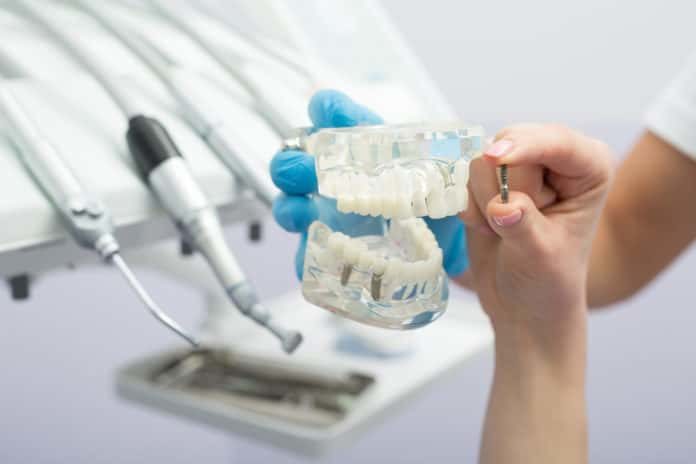Tooth loss could be the result of tooth decay, oral health issues, injury or gum disease. Prolonging the procedure of replacing missing teeth can affect the health of the jawbone and lead to other complications such as jaw point pain, and changes in appearance. This is where dental implants come into the picture. These are artificial tooth roots implanted to support or restore a missing tooth or teeth. Dental implants not only prevent further deterioration of jawbone, they also bring back the lost self-confidence of individuals with missing teeth. Let’s learn more about dental implants, their types, sizes, procedure, and other aftercare.
What are the types of dental implants?
There are two types of dental implants: single stage and two stage.
Single-Stage Implants
A single-stage procedure involves a surgery to place a longer implant into the jaw, and then stitching the gum in a way the implant head is visible. This simplifies the abutment and temporary restoration, which can later be done without any surgery to expose the head. Single -stage dental implants involve Subperiosteal. These are commonly used for patients who have insufficient bone height, as it holds the dentures in place.
Two-Stage Implants
Two-stage implants is basically a two-step surgery. The first step in the surgery involves placing the implant into the jaw bone and stitching the area to close the gum tissue. The second step surgery takes place several months after healing to attach an abutment and for temporary restoration. It involves Endosteal, placed as an option for a bridge or removable denture. Endosteal implants comprise screw types (threaded), cylinder types (smooth) or bladed types.
What are the sizes of dental Implants?
Implants have different sizes or platforms.
Standard Platform
Ranging in diameters from 3.5 mm to 4.2 mm, standard platforms are short and narrow, placed in the frontal positions of the mouth.
Wide Platform
Ranging in diameters from 4.5 mm to 6 mm., wide platforms are placed in the back positions of the mouth.
Mini or Narrow Body Platform
Ranging in diameters from 2 mm to 3.5 mm, mini or narrow body platforms are used for patients with insufficient space between tooth roots. These basically fill up space. Also, these may be used for patients with insufficient bone density.
What materials are used for dental Implants?
Coatings
The surface of the material affects the stability of the treatment and the way it integrates itself in the long term. A porous surface helps in more bone contact as compared to a machined titanium surface. There are other surfaces to choose from like grit-blasted or acid -etched and roughened surface, a plasma-sprayed hydroxyapatite coating, and a microgroove or plasma-sprayed titanium surface.
Connectors
Implants with different shapes/types of heads require different types of connectors. These are for the restoration and abutment, which is attached to the head.
Internal Hex Connectors: The hexagonally shaped internal hex connectors act as openings in the implant head where the restoration/abutment is screwed.
External Hex Connectors: External Hex Connectors are also shaped as their name suggests, like a hexagon. These are placed on the top of the implant head.
Internal Octagon Connectors: These are shaped like octagons and placed as openings in the implant heads into which the restorations/abutments are screwed.
How do you go about dental implants?
Osseointegration is the first step in the dental implants. It is a process by which the implant ties itself to the jaw bone. This takes six months to heal, post which crown restoration is done. If osseointegration is not successful, the implant will fail.
Steps for dental implant
Preparation: A dental implant restoration comprises a titanium material screw and a crown. A pilot hole, small in size, is drilled at the jaw sites where there is no tooth. These will hold the titanium screws to keep the implants in place. The process needs great skill and expertise to avoid damaging significant face structures. Dentists may use surgical guides aided by CT scans for the implants.
Placement: In this step, the pilot hole is widened, the surrounding gum tissue is secured to cover the implant, after which a protective screw envelops the site until it heals and osseointegration occurs. Six months after the implant heals, it is uncovered and an abutment is attached for holding the crown. Once the abutment is in place, a temporary crown is put in. The dentist uses this to serve as a model around which the gum shapes itself so that the growth is ideal. The implant is later completed, replacing a temporary crown with a permanent crown.
What do you need to keep in mind?
- Diagnosis of any underlying oral health issues is necessary beforehand.
- Issues of tooth decay and gum disease might affect the treatment negatively. For instance, smoking may pose a risk of failure of implants. It can affect osseointegration, the initial process of a dental implant.
- Dental implantation may require some additional treatment beforehand in cases of certain health hazards like diabetes, cancer or periodontal disease.
Aftercare for dental implants
Maintaining oral hygiene is essential to take care of the implant. This will ensure proper fusing of the implant with bone structure. Also, missing flossing and brushing habits is a primary cause of failure as infection can occur in the surrounding areas and interfere with the progress of the implant. Smoking should be avoided post-implant procedures.
For provisional restorations too, proper cleaning is needed to make sure that the healing and fusing process goes well. After the first process of the implant, you may experience swelling of gums and face and /or minor bleeding. There could be minor bruises on the implant site. Your dentist shall prescribe pain medications. This will relieve you of any discomfort. Follow a soft food diet for around a week after surgery.
Healing from a dental implant takes up to six months. The abutment of a crown can take up to two months. This can vary a bit. Follow-up appointments in between to check your progress are important.
At the last step of the procedure, your dentist shall remove any stitches if needed. So, go for the follow-up. This step is, however, not required in case of self-dissolving stitches.
If the dental implant is taken care of properly, it can last for more than 40 years.
Final Words
A consultation with your dentist or periodontist will clarify the various aspects to be considered while making the implant. Whether you need a simple implant or a soft tissue graft or a mini implant will be ascertained after examining the bone or gum tissue. If bone or gum tissue are less, a soft tissue or mini implant might be required. X-rays and CT scans might be required to examine your bone density, quantity and gum structure. This also ensures where exactly they should be placed.
After careful examination, your dentist will prescribe which types of dental implants are appropriate for you. Also, dentist will discuss the length of the treatment process, the anesthesia options, and sedation dentistry, the probable cost of the dental implants, etc.
Dental implants impart patients the strength and stability needed to eat all kinds of foods they love and chew easily. They also help to stimulate and maintain jaw bone, adding longevity to it and aiding in the support of facial features. Also, they boost the self-confidence one might has lost after tooth loss.















